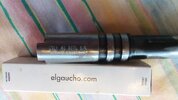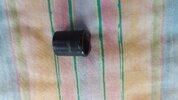mountainroads
Member
@Slamfire: I'm usually pretty generous with lube products  Seriously. even in my .177.
Seriously. even in my .177.
- MR
- MR
My suggestions: Replace the recoil spring with a new recoil spring. The standard was 16 lb, go buy an 18 also just to see. Your spring is 40 years old and has got to taken a set. This is important in terms of timing. If the slide is moving too fast, the cartridge in the magazine will often be jammed on the feed ramp.
Next, use ammunition appropriate for the pistol. That is, ball ammunition.
The original 1910 cartridge was loaded with a 230 FMJ and 5.0 grs Bullseye Pistol powder for a desired velocity of 800 fps. You cannot go wrong copying this load.
And you can see, the velocity spec found in Clawson's book of the 1911 is verified in period ammunition

Military match ball, close enough


I think this is good

This is a good cast bullet load. A 230 LRN with 4.5 grains Bullseye pistol powder, I set the OAL to 1.250 because I have some short throated 1911's

in other 1911's, it chronographs at 800 fps, on this day, the weather was cold

the standby

Something else, when building a period NM pistol, the gunsmith peened the frame rails, coated the same with grinding compound, and beat the slide back and forth till he achieved a level of resistance that he felt was appropriate for a tight fit. With these tight, hand built 1911's, the advice back in the day was "your elbow is the drip point" . Keep your 1911 swimming in oil. Oil, oil, oil. Oil the rails, oil the locking lugs, oil the swinging link, oil the end of the barrel, and put a drop of oil where it will slide down to the sear surfaces. Never let it run dry.
You might remove the extractor and clean out that recess as mice may have built nests in the extractor hole. That could cause tension issues.
Don't know what magazines you are using, buy the best and see if any are more reliable than others. Government magazines were built by the low bidder, and what you have, who knows if it is real GI or some counterfeit, or its previous history. Mil Spec ain't next to Godliness. Especially if it was rejected by the Government Inspector, and "somehow" got into the market place. You think the OEM maker junked rejected magazines, when they can make profit selling them to gullible buyers?
If your 1911 is only reliable with 230 FMJ, that is fine. The pistol came from the factory ready to run with ball ammunition. That was all you would have received in combat anyway, the Army never issued LWSC target ammunition to front line troops.







